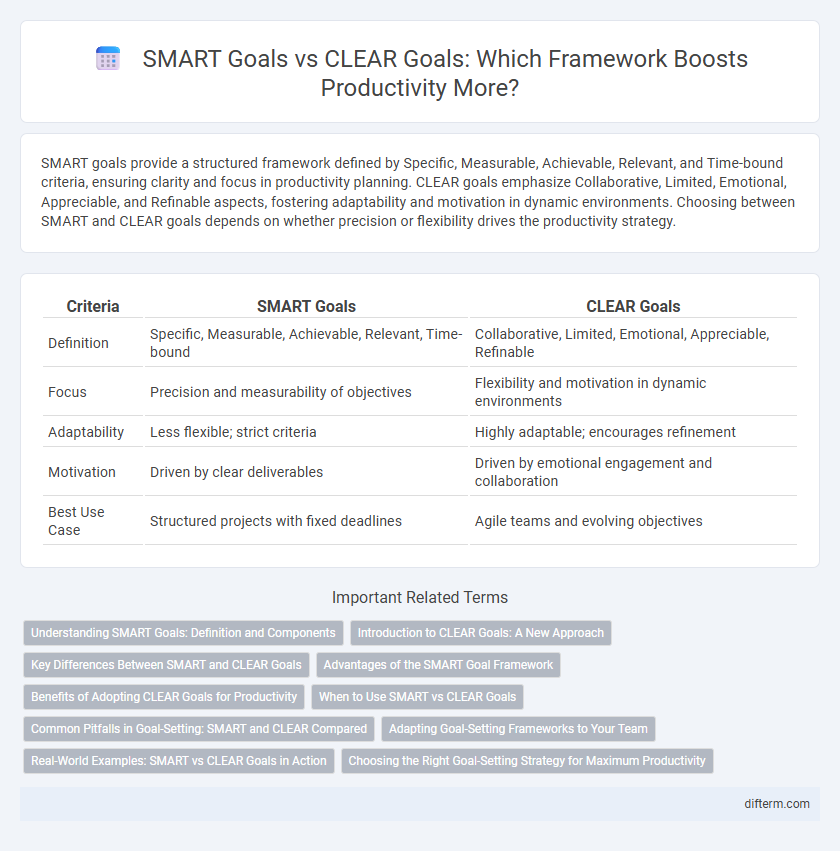SMART goals provide a structured framework defined by Specific, Measurable, Achievable, Relevant, and Time-bound criteria, ensuring clarity and focus in productivity planning. CLEAR goals emphasize Collaborative, Limited, Emotional, Appreciable, and Refinable aspects, fostering adaptability and motivation in dynamic environments. Choosing between SMART and CLEAR goals depends on whether precision or flexibility drives the productivity strategy.
Table of Comparison
| Criteria | SMART Goals | CLEAR Goals |
|---|---|---|
| Definition | Specific, Measurable, Achievable, Relevant, Time-bound | Collaborative, Limited, Emotional, Appreciable, Refinable |
| Focus | Precision and measurability of objectives | Flexibility and motivation in dynamic environments |
| Adaptability | Less flexible; strict criteria | Highly adaptable; encourages refinement |
| Motivation | Driven by clear deliverables | Driven by emotional engagement and collaboration |
| Best Use Case | Structured projects with fixed deadlines | Agile teams and evolving objectives |
Understanding SMART Goals: Definition and Components
SMART goals enhance productivity by providing Specific, Measurable, Achievable, Relevant, and Time-bound criteria that clarify objectives and track progress efficiently. These five components ensure that goals are well-defined, realistic, aligned with broader objectives, and set within a clear timeframe to maintain focus and motivation. Understanding SMART goals equips individuals and teams to prioritize tasks, measure outcomes, and adjust strategies for optimal performance and goal attainment.
Introduction to CLEAR Goals: A New Approach
CLEAR Goals represent a modern methodology for enhancing productivity by emphasizing Collaborative, Limited, Emotional, Appreciable, and Refinable objectives. This approach fosters adaptability and team engagement, contrasting with the traditionally rigid SMART framework focused on Specific, Measurable, Achievable, Relevant, and Time-bound criteria. CLEAR Goals promote dynamic goal-setting that aligns more closely with fast-paced work environments and evolving priorities.
Key Differences Between SMART and CLEAR Goals
SMART goals emphasize Specific, Measurable, Achievable, Relevant, and Time-bound criteria to enhance clarity and trackability in productivity. CLEAR goals prioritize Collaborative, Limited, Emotional, Appreciable, and Refinable elements, fostering adaptability and motivation within dynamic work environments. The key difference lies in SMART's structured, outcome-focused approach versus CLEAR's flexible, human-centered methodology aimed at continuous improvement.
Advantages of the SMART Goal Framework
The SMART goal framework offers clear advantages in productivity by providing Specific, Measurable, Achievable, Relevant, and Time-bound criteria that drive focused and trackable progress. This structured approach enhances goal clarity and accountability, enabling individuals and teams to prioritize tasks efficiently and avoid ambiguity. Data shows that organizations implementing SMART goals experience higher completion rates and improved performance metrics due to precise goal-setting and consistent evaluation.
Benefits of Adopting CLEAR Goals for Productivity
CLEAR goals--Collaborative, Limited, Emotional, Appreciable, and Refinable--enhance productivity by fostering stronger team engagement and adaptability compared to traditional SMART goals. This approach emphasizes emotional connection and continuous refinement, which drives motivation and sustained focus toward achieving objectives. Adopting CLEAR goals results in improved clarity, better resource allocation, and faster response to changing priorities in dynamic work environments.
When to Use SMART vs CLEAR Goals
SMART goals excel in structured environments requiring specific, measurable, achievable, relevant, and time-bound targets, ideal for long-term projects and performance evaluations. CLEAR goals are better suited for dynamic, fast-paced settings emphasizing collaboration, flexibility, and emotional engagement to foster innovation and adaptability. Choosing between SMART and CLEAR goals depends on the project's complexity, team dynamics, and the need for precision versus creativity.
Common Pitfalls in Goal-Setting: SMART and CLEAR Compared
Common pitfalls in goal-setting often arise from the limitations of SMART goals, which can be too rigid and overlook the importance of emotional commitment and flexibility. CLEAR goals address these gaps by emphasizing collaboration, learning, emotional resonance, adaptability, and refinement, which help maintain motivation and relevance over time. Comparing both frameworks highlights that integrating adaptability and emotional engagement in goal-setting improves productivity and goal attainment.
Adapting Goal-Setting Frameworks to Your Team
SMART goals emphasize Specific, Measurable, Achievable, Relevant, and Time-bound criteria, offering clear structure for individual accountability and performance tracking. CLEAR goals--Collaborative, Limited, Emotional, Appreciable, and Refinable--prioritize flexibility and team engagement, promoting adaptability and ongoing motivation in dynamic work environments. Choosing between SMART and CLEAR frameworks depends on your team's need for precision versus adaptability, allowing tailored goal-setting that enhances productivity and alignment with organizational priorities.
Real-World Examples: SMART vs CLEAR Goals in Action
SMART goals emphasize Specific, Measurable, Achievable, Relevant, and Time-bound criteria, making them ideal for project management and sales targets, such as increasing quarterly revenue by 15%. CLEAR goals--Collaborative, Limited, Emotional, Appreciable, and Refinable--foster team motivation and adaptability, exemplified by startup product development teams iterating features based on user feedback. Companies like Google use SMART goals for structured performance reviews, while Agile teams apply CLEAR goals to maintain flexibility during sprints.
Choosing the Right Goal-Setting Strategy for Maximum Productivity
Choosing the right goal-setting strategy significantly impacts productivity by aligning efforts with clear outcomes. SMART goals emphasize Specific, Measurable, Achievable, Relevant, and Time-bound criteria to create structured targets that enhance focus and accountability. CLEAR goals prioritize Collaborative, Limited, Emotional, Appreciable, and Refinable elements, fostering adaptability and motivation in dynamic work environments.
SMART Goals vs CLEAR Goals Infographic

 difterm.com
difterm.com